#reef day
Explore tagged Tumblr posts
Text

Soar through the weekend with the reef manta ray (Mobula alfredi)! This “winged” sea critter is typically dark on top and white or cream on its underside to help it camouflage from both directions. Something else you may not know about mantas: They have a high brain-to-body-mass ratio and the largest brain of any fish in the sea! They’re playful and curious, and research suggests some ray species show indications of self-awareness.
Photo: Sylvie Omnè, CC BY-NC 4.0, iNaturalist
#science#nature#natural history#animals#fact of the day#did you know#manta ray#reef manta ray#ocean#marine biology
700 notes
·
View notes
Text

moar baby white pearl for mental stability
#cookie run kingdom#cookie run#black pearl cookie#white pearl cookie#one day I'll decide on a “pre-litter” Grand Reef design but that might be a bit-#CRK#doodles#Guppy au#kinda
2K notes
·
View notes
Text
"The world's coral reefs are close to 25 percent larger than we thought. By using satellite images, machine learning and on-ground knowledge from a global network of people living and working on coral reefs, we found an extra 64,000 square kilometers (24,700 square miles) of coral reefs – an area the size of Ireland.
That brings the total size of the planet's shallow reefs (meaning 0-20 meters deep) to 348,000 square kilometers – the size of Germany. This figure represents whole coral reef ecosystems, ranging from sandy-bottomed lagoons with a little coral, to coral rubble flats, to living walls of coral.
Within this 348,000 km² of coral is 80,000 km² where there's a hard bottom – rocks rather than sand. These areas are likely to be home to significant amounts of coral – the places snorkelers and scuba divers most like to visit.
You might wonder why we're finding this out now. Didn't we already know where the world's reefs are?
Previously, we've had to pull data from many different sources, which made it harder to pin down the extent of coral reefs with certainty. But now we have high resolution satellite data covering the entire world – and are able to see reefs as deep as 30 meters down.
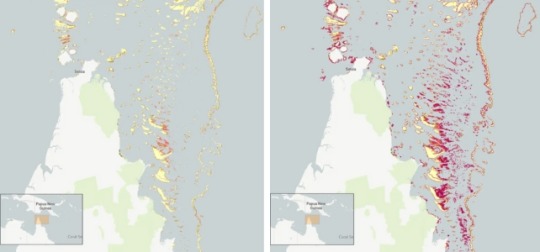
Pictured: Geomorphic mapping (left) compared to new reef extent (red shading, right image) in the northern Great Barrier Reef.
[AKA: All the stuff in red on that map is coral reef we did not realize existed!! Coral reefs cover so much more territory than we thought! And that's just one example. (From northern Queensland)]
We coupled this with direct observations and records of coral reefs from over 400 individuals and organizations in countries with coral reefs from all regions, such as the Maldives, Cuba, and Australia.
To produce the maps, we used machine learning techniques to chew through 100 trillion pixels from the Sentinel-2 and Planet Dove CubeSat satellites to make accurate predictions about where coral is – and is not. The team worked with almost 500 researchers and collaborators to make the maps.
The result: the world's first comprehensive map of coral reefs extent, and their composition, produced through the Allen Coral Atlas. [You can see the interactive maps yourself at the link!]
The maps are already proving their worth. Reef management agencies around the world are using them to plan and assess conservation work and threats to reefs."
-via ScienceDirect, February 15, 2024
#oceanography#marine biology#marine life#marine science#coral#coral reefs#environment#geography#maps#interactive maps#ai#ai positive#machine learning#conservation news#coral reef#conservation#tidalpunk#good news#hope#full disclosure this is the same topic I published a few days ago#but with a different article/much better headline that makes it clear that this is “throughout the world there are more reefs”#rather than “we just found an absolutely massive reef”#also included one of the maps this time around#bc this is a really big deal and huge sign of hope actually!!!#we were massively underestimating how many coral reefs the world has left!#and now that we know where they are we can do a much better job of protecting them
438 notes
·
View notes
Text

#CHEST 👀#Oscar Piastri#our pale ass Aussie boy is saving the reef#I think this is 5-10 business days people
974 notes
·
View notes
Text



boop!!
credit to @/peregreen for the transparent paws
please credit if you use! reblogs are appreciated
#boop#april fool's day#boop o meter#id in alt text#userboxes#endos dni#also huge shoutout to peregreen those were the only transparent paws we could find#reef's userboxes
167 notes
·
View notes
Text
crop top

#makeaterriblecomicday2024#make a terrible comic day 2024#reefsharkivist art#reef sharkivist#autobiography#happened today
74 notes
·
View notes
Text
Todays shark is...
The White-Tip Reef Shark!

Fun Fact: Primarily nocturnal, they shelter in caves during the day and often return to a home cave for periods of days, weeks or more!
40 notes
·
View notes
Text
Fish of the Day
Today's fish of the day is the reef triggerfish!

The Reef Triggerfish, also known by Hawiian name humuhumunukunukuāpuaʻa, and scientific name Rhinecanthus rectangulus, is known for its prevalence across the indo-pacific, and for being Hawaii's state fish! Their range stretches from the Hawiian islands to the Eastern Philippines,Northern Australia, Indian ocean, small sections of the red sea, and the mediterranean. This fish lives its life out along reefs and other sea shelves, as their hunting style consists mostly of digging in the sand and rocks for prey, similar to pigs digging for truffles. Their diet consists of reef invertebrates, algae, small crabs, sea urchins, and other benthic animals. This diet can support them to sizes of 10-12 inches, which is the smaller range for triggerfishes.
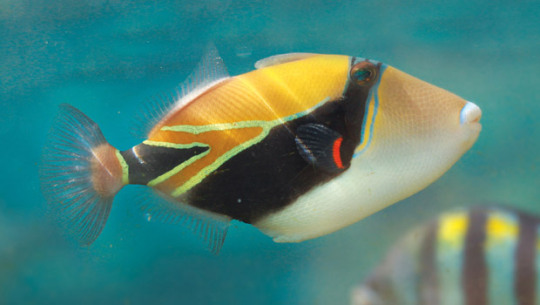
These fish, like many other triggerfish, gain their name from their ability to fire and aim jets of water, which it will also use to hunt and find prey beneath the surface. They also will use this against other fish and larger beings in their territory, as reef triggerfishes are intensely territorial, and solitary other than in breeding season. This can manifest in cases where reef triggerfish chase and bite humans viewing reefs. When met with predators, the reef triggerfish, similar to other triggerfish, finds small holes within rocks or corals that it will lodge itself within. The first dorsal spine will act as a physical barrier that can lock in an upright position, making it harder for predators to pry it out of their safe havens. Due to the shape of their spines and fins, these fish can swim forward, backward, and hover in the water.
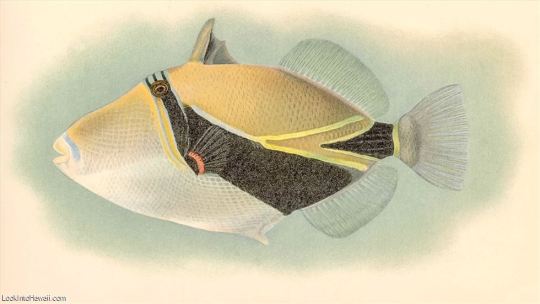
Like most fishes, reef triggerfish have a breeding season from April-August, and classically have females lay eggs and males fertilize in groups. This being the one of the only times they interact with other of their species intentionally. Then after this, a female will build a nest, and wait with eggs until a few weeks after they hatch, at which point the fish will set out independently. Reef triggerfish can also change coloration, turning a more vibrant shade for breeding seasons. They will also present vibrantly when healthy, sexually mature, and unthreatened. They can also change colors to better match an environment around them, and do so nightly when they settle into holes to rest.

Have a wonderful day, everyone!
#fish#fish of the day#fishblr#fishposting#aquatic biology#marine biology#animal facts#animal#animals#fishes#informative#education#aquatic#aquatic life#nature#river#ocean#reef triggerfish#triggerfish
58 notes
·
View notes
Text

artistic rendition of whatever is happening in the rp chat between me and @sallyastral tmw you and your boyfriend have to take care of gallagher's weird ahh dog
#doodle#shitposting#honkai star rail#hsr#hsr blade#hsr sampo#mochi's art#average day in dreamflux reef btw
54 notes
·
View notes
Text
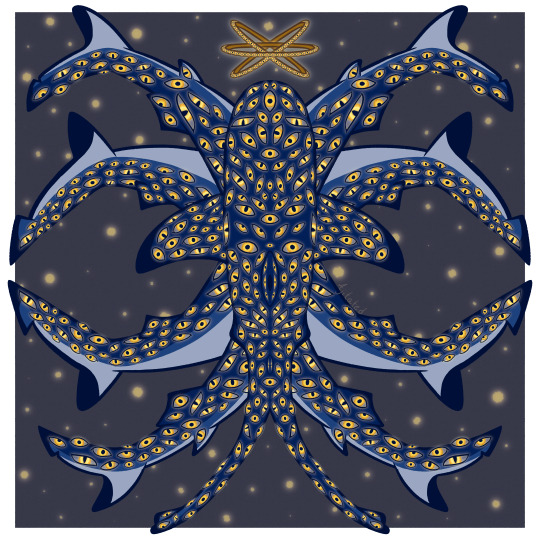
My piece for the first days of Funguary (Celestial, Mycena Subcyanocephala) and Fishuary (Shark)!
The shark I chose was the Blacktip Reef Shark 'cause they're super cute, and I wanted to give it "biblically accurate angel" vibes for 'celestial'. It ended up less 'mushroom' than intended, but hopefully the inspiration is still clear when you see what the actual fungus looks like!
#this took me multiple extra days to post cause i accidentally made the file too big and couldnt upload it 😭#funguary#fishuary#fishuary2024#funguary2024#ajitated art#shark#blacktip reef shark#mycena subcyanocephala#eyes#biblically accurate shark#digital art#original art#many eyes#extra eyes#celestial#im actually really proud of how this turned out#i worked super hard on it
145 notes
·
View notes
Text
This is the ideal male body. You may not like it, but this is what peak performance looks like.
#BO-DAY LAN-GUAGE#reef stonefish#i lose my shit every time they swim oh buddy you are not adapted for that huh
79 notes
·
View notes
Text
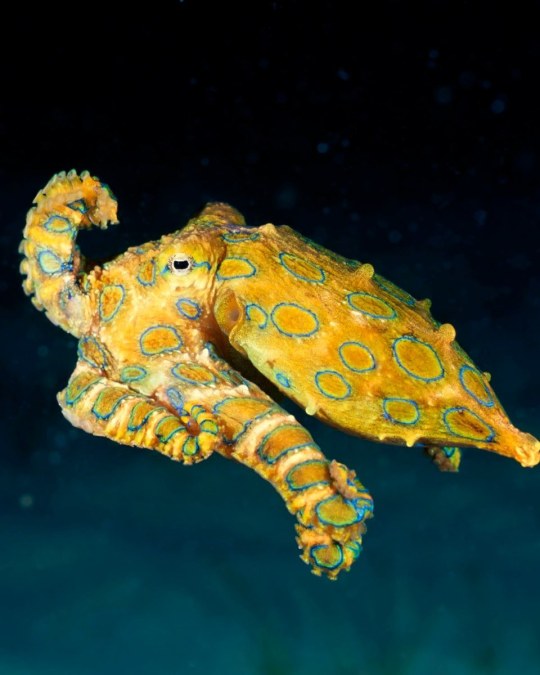
Did you know? Blue-ringed octopuses (members of the genus Hapalochlaena) are among the world’s deadliest cephalopods. Found in coral reefs in the Indian and Pacific oceans, these critters typically measure less than 8 in (20.3 cm) long. But, they pack a venomous bite that is potent enough to instantly paralyze, and even kill, a human being.
Photo: Angell Williams, CC BY 2.0, flickr
#science#nature#natural history#animals#fact of the day#did you know#octopus#blue ringed octopus#ocean life#marine biology#coral reef#cephalopods
856 notes
·
View notes
Text
Decided to doodle more pre-litter Grand Reef Cookie because he is adorable
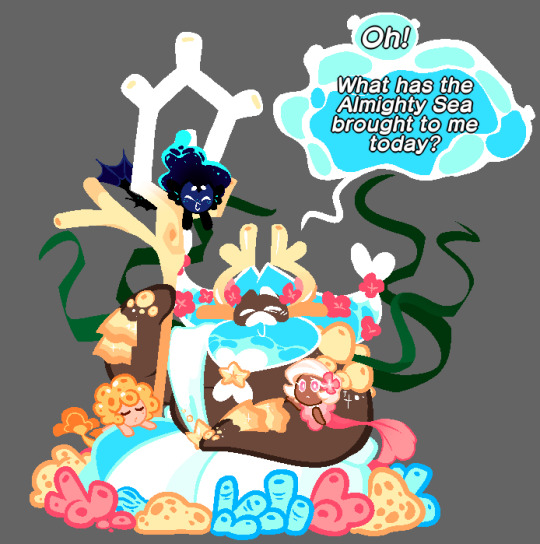


#All the little ones sleep in a designated “nursery” within an underwater cave in the reef#Grand Reef didn't need sleep back in the day so it was easy to tend to the guppies when they needed him#Now he does need it to help himself feel slightly better#a lot#that last one's rendering gave me sores#auhg#cookie run kingdom#cookie run#crk#Grand Reef Cookie#fan cookie#cookie run oc#cookie run ocs
671 notes
·
View notes
Text

#octonauts#captain barnacles#kwazii octonauts#he’s in the bg I needed to include him#Artificial Reef Episode#ignore the fact that I didn’t post for an entire day yesterday#anywayssssssss#good morning octonauts nationnnnn 💕#rise and grind 👹👹👹#starting off the morning with a beautiful man
25 notes
·
View notes
Text

WE GOT CANNON MUSIC INSTRUMENTS FOR THEM YOU DON'T KNOW HOW HAPPY I AM
#abyss crew#pluto talks#sky cotl#fun fact: the only days i play is when they have a daily#i get like 3 different friends telling me that oh yeah today is treasure reef daily#i love it
20 notes
·
View notes
Text
I don’t remember if there was an underwater fashion runway last year but it’s interesting.

Someone got creative and decided to tell a short story.
#days of style#treasure reef#sky children of the light#sky cotl#thatskygame#thatgamecompany#sky cotl before and after
23 notes
·
View notes